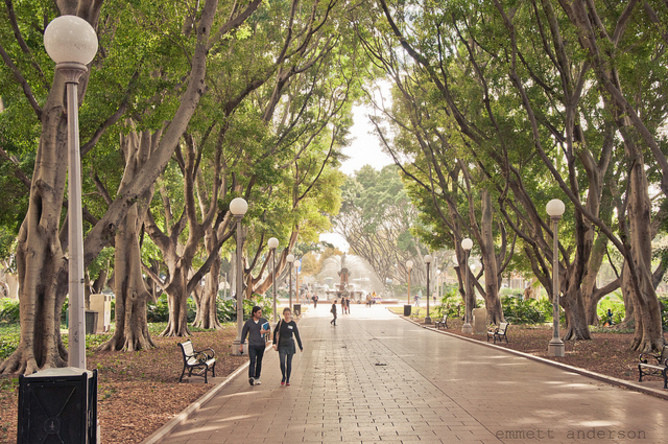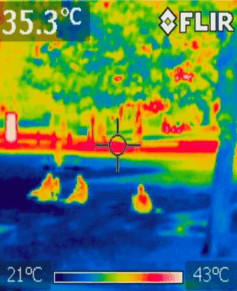Can trees cool the city and how?
A general study is necessary to eliminate all doubts and fully exploit the benefits of trees.
In any city in the world, trees are grown for the purpose of temperature control and air conditioning. However, while many scientists are skeptical of the air purifying effect of urban greenery , others continue to ask the question: Do they really cool the city?
The simplest experiment to doubt this is to compare the temperature in the air in a park with a nearby street.
This method often comes with disappointing results. In many cases a large park with large canopy has a daytime air temperature of no more than 1 ° C compared to the nearby area. At night even higher temperatures.

The air temperature in the park is less than 1 degree Celsius compared to the nearby area.(Photo: emmett anderson).
To explain the paradox in this thinking, we must look more closely at the operation of heat currents in the city. In fact, how did trees cool the city and how can we measure this?
Cooled by shade
Theoretically, plants can provide cooling in two ways: providing shade and t through a transpiration process. Mostly we often feel the benefits of trees through the first way.
As mentioned, the air temperature in the park is only 1 ° C below the outside, fortunately our feeling does not depend much on that. We feel cooler when sitting under a tree because this feeling is the result of how much radiation we absorb and the amount of heat we lose by the surrounding environment.

The temperature dropped significantly on the ground, under the trees.
A canopy acts as an umbrella that can prevent 90% of the solar radiation that we absorb. Besides, it also reduces the temperature of the ground area where we sit. This helps the body quickly escape heat and lower our actual physiological temperature.
Trees can also cool buildings, especially when they cover the east and west , at windows or outside walls. Both the research model and practical surveys in the US indicate that shade of trees can reduce the cost of air conditioning in private homes by 20-30%.
Cool by evapotranspiration
Trees are also used to solve the bigger problem: lowering the temperature of the whole city . During hot weather, the air temperature in a city may be reported to be 7 ° C higher than the nearby suburbs. This happens especially on hot nights.

Temperature chart of urban and surrounding areas.
The big problem in cities is the asphalt road . They are made black and absorb almost all the high-energy radiation coming from the sun. The pavement temperature can reach 40-60 o C in the morning. This heat is stored and released to the atmosphere at night. Therefore, even without the sun, the night the city became a heat island.
Urban green trees can resist this part of the process by preventing radiation from reaching the road . However, they must consume the sun's energy in a different way: the process of evaporation.
When the sun shines down on the canopy, on the one hand it has to consume water to cool it, on the other hand the steam escaping from the foliage is like the process of sweating and cooling the city.

Asphalt will turn the city into a heat island.
The effects of transpiration can be quantified in two ways. The first way is to measure the temperature in the leaves to compare with the air temperature. We often get a 2-3 o C lower result. Unfortunately, this number is not reliable because the leaves are cooler even when they are not drained by convection.
A better way to calculate the cooling effect of plants: measure the amount of water it is losing. Scientists will estimate this from the plastic flow on the stem or the amount of water released from each single leaf.
This method shows that canopy can consume 60% of radiant energy to evaporate water vapor. However, there is one drawback: plants only cool this way when it grows well. Depending on the species, there is a different cooling capacity and degradation over time if they grow poorly due to soil conditions.
There has never been a general study

A general study is needed to fully and rationally exploit the benefits of trees.
The reason anyone has doubts about the cooling effect of urban greenery is that there has never been a general study evaluating that. Sporadic experiments even took place without the consistency and reliability of the two measurement methods mentioned above. A general study requires the cooperation of many engineers, physicists, biologists and architects to work together to build a computational model.
Above all, trees must be placed in a specific and detailed city environment to assess its complex impact on the air and heat flow circulating in the city. Previous local experiments could not convince difficult scientists.
Of course, scale research will consume a lot of resources. However, if we can fully understand the effectiveness of urban greenery, we can better exploit how they are cooling the city and turning every neighborhood into a place worth living in the future.
- Crops help the house cool on hot days
- Unusual cooling way of koalas
- Attend the cleanest cities in the world
- How to cool your body in a hot day without air conditioning
- 12 ways to make your home cooler in hot days
- Benefits when you take a cool bath for 7 consecutive days
- Miraculous plants know
- Alarming the decline of old trees
- 'Ghosts' row in England
- Flower carpet holds the beach environment
- Why should the fan turn off when it is too hot?
- Planting 3,500 trees to protect the environment in Hai Phong
 Why do potatoes have eyes?
Why do potatoes have eyes? 'Tragedy' the world's largest carnivorous life: Death becomes ... public toilet
'Tragedy' the world's largest carnivorous life: Death becomes ... public toilet Tomatoes were once considered 'poisonous' for 200 years
Tomatoes were once considered 'poisonous' for 200 years Detecting microscopic parasites on human face
Detecting microscopic parasites on human face